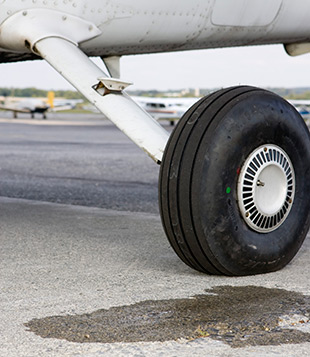Aircraft Maintenance: Beware common points of failure on brakes
Brake system basics and maintenance, part 2
In our last segment, we reviewed the design and flow of the typical general aviation aircraft brake system. This time, let’s look at the common points of failure.

As we discussed, we are dealing with a fairly simple hydraulic system consisting of master and slave cylinders, associated plumbing, and disc and pad components that supply the friction used for braking. As long as the system stays sealed and intact, it’s fairly bullet-proof. However, wear, age, and corrosion all take their toll, and there are many potential points of failure that must be inspected and maintained.
Hydraulic fluid leaks
The most common failures in aircraft braking systems are loss of fluid and the introduction of air into the system. Hydraulic fluid is non-compressible, which is the key to a positive connection between the brake pedal and the wheel. Air, on the other hand, can be easily compressed. Any time that hydraulic fluid is leaking out, chances are air is leaking in. The result is, at best, a very spongy feeling when pressing the brake pedal. At worst, it can be a complete loss of braking capability.
Leaks within the hydraulic system can be internal or external. Internal leaks typically happen within the master cylinders, where the internal valves and O-rings lose their sealing ability, resulting in loss of effectiveness in pressurizing the system when the brake pedals are pressed. If these internal O-rings deteriorate or tear, they lose the ability to hold this seal, and fluid will leak through. In addition, any contaminants in the fluid can cause trouble for the sealing of the moving O-rings used in the system.
External leaks are the ones that cause loss of fluid from the system (either inside or outside the aircraft). These types of leaks also are the ones that let air in. Any junction in the hose system can be a source of leaks if it is not properly tightened or if it is damaged. Flexible brake hoses are another point of failure. Most hydraulic hoses should be replaced every five years. As these hoses age, they can deteriorate from the inside. Small pieces of rubber can flake off and contaminate the system. In addition, since the hoses are deteriorating from the inside out, there may be no signs of impending failure before the hose bursts.

Hard lines are just as vulnerable. In this case, the enemies are corrosion, fatigue, and wear. Corrosion can come from the outside or the inside. The outside of the lines should be carefully inspected for cracks, corrosion, or fretting wear in any place where the lines rub against another component. The inside of the lines can corrode as well if water or other contaminants enter the system. The best preventive maintenance is to change the fluid on a regular basis.
Aluminum brake lines are rarely replaced until they show signs of failure. The problem is that in some installations, even these hard lines must flex when in use. Over the years, this flexing causes metal fatigue and can eventually result in failure under pressure.
Mechanical failures
Most mechanical failures occur at the wheel and caliper. Again, wear and corrosion are the culprits. The brake caliper and pressure plate have to move in order to clamp down on the brake disc. Two smooth pins on the caliper fit through a bracket (or torque plate) attached to the axle. If these pins become corroded, the caliper will stick and will not operate properly.
Typically, there are two or four brake pads on each caliper. One is riveted to the back plate and the other is riveted to the floating pressure plate. If these pads are allowed to wear beyond their limits, the rivets can scrape against the disc, and the linings can crack and fail.
The final mechanical failure can be failure of the disc itself. The friction surface of the disc can become rusted and pitted if the aircraft sits for long periods of time without flying. Every time that the brakes are used in normal operations, the brake pads naturally clear the disc of light rust. When the aircraft is not flown for some time, this light rust can progress into serious damage. And, the disc surface is not the only area susceptible to failure. In some cases, corrosion at the joint where the disc surface turns 90 degrees to enter the wheel can become so serious that the entire disc is in danger of falling apart.
In our next segment, we’ll get our hands dirty and talk about replacing brake linings and discs. Until then, happy flying!
Interested in aircraft maintenance? View the archives of Jeff Simon’s Aircraft Maintenance series.
 Jeff Simon is an A&P mechanic, pilot, and aircraft owner. He has spent the last 14 years promoting owner-assisted aircraft maintenance as a columnist for several major aviation publications and through his how-to DVD series: The Educated Owner. Jeff is also the creator of SocialFlight, the free mobile app and website that maps over 20,000 aviation events, airport restaurants, and educational aviation videos, including many how-to videos for the subjects of these articles. Free apps are available for iPhone, iPad and Android, and on the Web at www.SocialFlight.com.
Jeff Simon is an A&P mechanic, pilot, and aircraft owner. He has spent the last 14 years promoting owner-assisted aircraft maintenance as a columnist for several major aviation publications and through his how-to DVD series: The Educated Owner. Jeff is also the creator of SocialFlight, the free mobile app and website that maps over 20,000 aviation events, airport restaurants, and educational aviation videos, including many how-to videos for the subjects of these articles. Free apps are available for iPhone, iPad and Android, and on the Web at www.SocialFlight.com.


